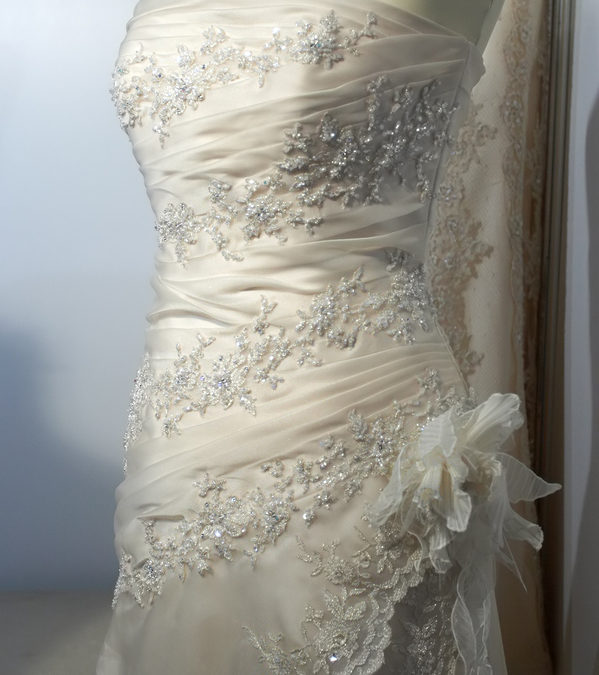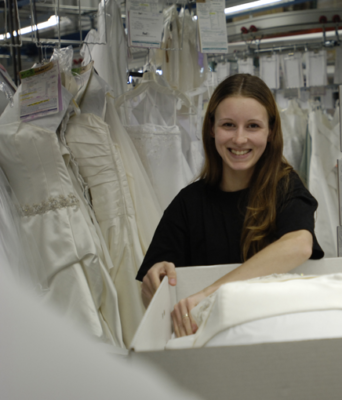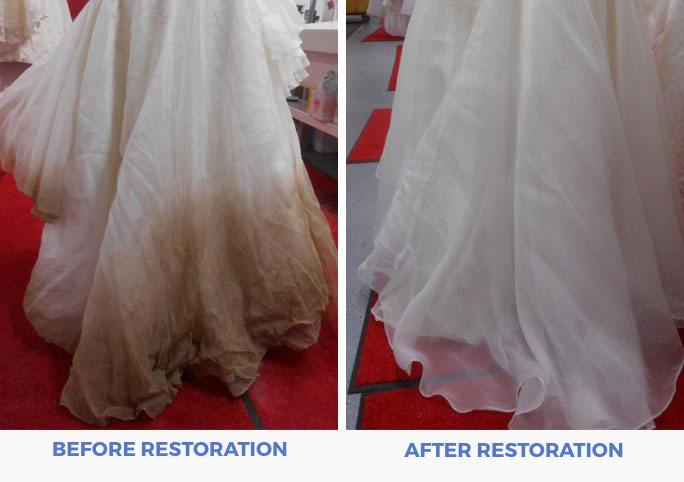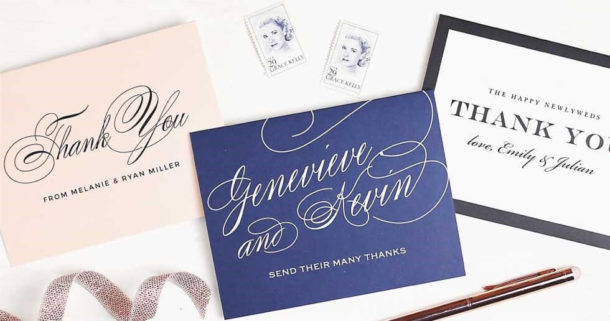The Differences Between Wedding Dress Preservation and Wedding Dress Restoration
Wedding Dress Restoration and Wedding Dress Preservation differ in several ways, yet still complement each other. Not sure which service is right for your needs? Read on as we break down the differences for you between Wedding Dress Preservation vs. Wedding Dress Restoration.
Wedding Dress Restoration:
Wedding Gown Restoration is the process of bringing an older, vintage or damaged wedding dress back (or close) to it’s original condition as possible. Here are the most common requirements for wedding dress restoration.
- Discoloration Repair: Generally, a wedding dress that is 20 years old or more usually will require wedding dress restoration. Wedding dresses in this age range have typically become yellowed and/or have noticeable brown spots. Restoration is a delicate process done completely by hand and can bring your dress very close to originally color and luster, depending on the extent of the discoloration.
- Stain Repair: Restoration is also necessary for a dress that has stains that were not professionally removed in a timely manner and have set into the fabric of the dress. Stains can often be caused by perspiration, champagne, or cake frosting that are overlooked. These type of stains are often not visible at first and then surface over time. Whether visible or invisible at the time, food, mud, and perspiration can damage the fabric and create holes or brown spots over time.
- Insect Damage Repair: Damaged fabrics from insects, such as moths, are another contributor to dresses needing wedding dress restoration. If not properly cleaned and preserved after the wedding moths can eat through the fabric of your wedding dress in various places. Your dress will need to be professionally repaired, hand cleaned, and properly preserved.
- Mold / Mildew Repair: Even if your dress was cleaned and preserved after your wedding, if it was not stored in a cool dry place as recommended, it can be subject to mold or mildew. This is most common when a wedding dress has been stored in a basement or attic and exposed to high humidity or dampness. A flood or leak can also lead to mold if the dress because wet or damp. Wedding dress restoration can help bring your dress back to it’s original condition.
- Smoke Damage: If for some reason, your dress was exposed to smoke from a fire, you will need to have your dress go through a professional restoration process.
- Trash The Dress: Did you enjoy a Trash The Dress photo session after your wedding? Depending on the extent of what was involved, your wedding dress may need to be restored.
- Other Damage: Do you have a cat that thought your dress was a climbing post? Or a dog that got out of control in your closet? If there has been other extensive damage to your dress’s fabric for whatever reason, chance are that it will need to be restored.
Wedding Dress Preservation:
Most wedding dresses only require professional wedding dress preservation if done soon enough after the wedding day and the dress has not been damaged extensively. Here is what’s involved in the wedding dress preservation process.
- Cleaning and Preservation: Wedding Dress Preservation includes both the cleaning and preservation of a wedding dress, and does not require pre-cleaning before having your wedding dress preserved.
- Stain Identification and Removal: Professional cleaning of a wedding dress involves the removal both visible and invisible stains. The most common visible stains are a soiled hemline (dirt and grass), makeup on the chest and bust area, lipstick, red wine, and other food. The most common stains that are often not visible initially include perspiration, champagne, white wine, and cake frosting. Reputable wedding dress preservation companies, will carefully hand inspect your dress under an ultra violet light to find and hand-treat both invisible and visible stains.
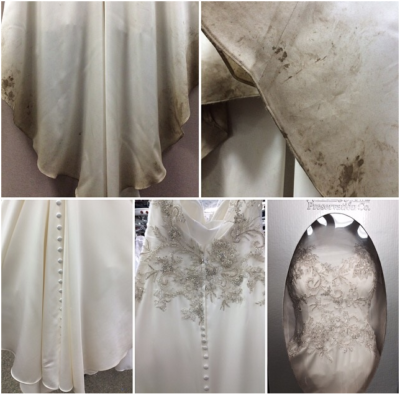
- Fabric Protection: Chemicals or solvents used to clean the wedding dress will prevent it from yellowing. Most companies no longer use PERC which is a known carcinogen. Some companies are now using only organic toxic free and environmentally friendly solvents, that will keep your dress from yellowing over time.
- Wrinkle Removal: Depending on the fabric, the dress will be steamed or hand pressed. Because wedding dresses are so delicate and intricate, great care must be taken to ensure the fabric and any beading or appliqués are protected.
- Packaging: In order to keep the shape of the bodice of your dress in tact, preservationists will typically place your cleaned and preserved dress on a bust form. This also makes for a lovely display through the viewing window. The bust form is carefully attached to the back of the preservation chest to keep it from shifting. The bottom of the dress is gently folded in layers in the lower portion of the preservation chest. If shoes are included, they are placed behind the bottom of the dress. If a veil is included it will usually be draped along the top and down the side of the dress so it can be seen through the viewing window. All of the materials in the preservation chest (bust form, tissue paper, cardboard, etc.) should also be acid-free or acid-nuetral.
- Preservation Chests & Storage: Preservation chests are usually very sturdy cardboard boxes that are made from acid-free materials. Flimsy boxes often used in ‘Do-it-yourself’ kits will usually not hold up or properly protect the dress over time, even if they are made from acid free materials. In addition, the viewing window should be made of polyester instead of plastic, as plastic can cause your dress to yellow from the chemicals in the plastic. An outer storage box is also recommended to keep UV rays from the gown’s fabric, which can cause yellowing.
- Guarantee: A guarantee against yellowing is usually offered by most professional wedding dress preservation companies. This is something you typically won’t see from a dry cleaner who will only clean your dress, unless they are sending it out to a specialist bend the scenes. Dry cleaners often come and go, so who knows if they will still be in business or the same owners down the road if there’s a problem. As a result, you’ll want to only entrust your dress to a company who has been in business for a long time.
Bottom Line:
If your dress is less than 20 years old and in good condition, you probably only need it professionally cleaned and preserved. If you have significant damage, yellowing, mold, mildew, brown spots, or insect damage, it will likely need to be restored. In either case, you will want to entrust your precious wedding dress (or your mother’s dress) to a highly reputable wedding gown preservation company such as the Affordable Preservation Company* that offers both wedding dress preservation and restoration.
*Affordable Preservation Company is the Elite Representative for The Wedding Gown Preservation Company who has been preserving wedding gowns for over 100 years. The Wedding Gown Preservation Company only works through it’s authorized dealers. Affordable Preservation Company takes great pride in their exceptional customer service as reflected in their Award Winning status on The Knot and WeddingWire.


